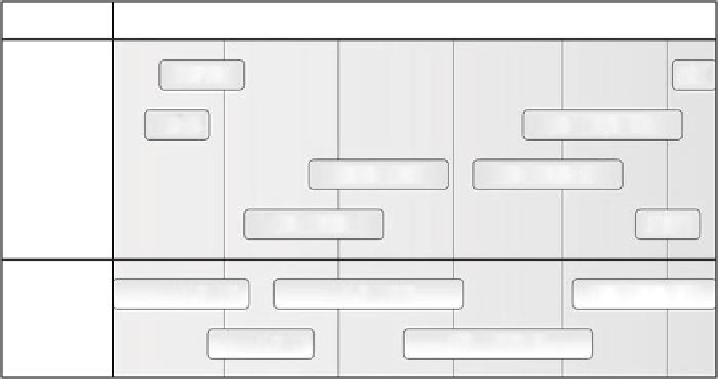Environmental Engineering Reference
In-Depth Information
13.11.4 Filtration Evolution
In another presentation, R. Miller [24] said that nanotechnology provides a new option to
conventional iltration technologies. Figure 13.5 [24] shows a conventional view of iltration
technologies and their removal abilities—ranging from ionic contaminants (salts and metals),
endotoxins, viruses, bacteria, dust and silt, cysts, and sand. Technologies and their removal
abilities noted in the igure are RO (ionic and molecular), nanoiltration (ionic and molecular),
UF (molecular and micro), and MF (micro and particle), and particle iltration (particles).
Miller noted that traditional iltration technologies could have limitations. For example,
sieving ilters that exclude contaminants because of their size may have the pitfalls of
energy use, gross iltration, and waste streams. Limitations for technologies that work
through chemical, adsorption, or kinetics (e.g., coalesce, IX, chemiadsorptive, and electro-
lytic) are residence time, chemical use, and treatment capacity.
Nanotechnology can represent the convergence of sieving and chemical-adsorption-kinetic
technologies. Nanoibers used in ilters offer the beneit of small diameters, large surface areas,
great porosity, a variety of materials, and ease of use with different iltration media.
One example is a CNT known as Nanomesh™ developed by Seldon. The CNT tech-
nology has been shown to effectively remove TOC,
Escherichia coli
, bacteriophage MS2
virus (MS2), Taura syndrome virus (TSV), yellow head virus (YHV), white spot syndrome
virus (WSSV), and infectious hypodermal and hematopoietic necrosis virus (IHHNV). For
instance, at an aquaculture laboratory, the company was able to get full removal of WSSV,
TSV, IHHNV, and YHV from 380 gal of seawater that had a challenge log ranging from 7.3
for TSV down to 5.5 for IHHNV. For TOC removal, the CNT nanotechnology was able to
treat an inluent tannic acid from 10.5 ppm down to 0.4 ppm, and an inluent humic acid
from 2.5 ppm down to 0.4 ppm. This performance came in treating 120 gal of water during
in-house NSF P248 tests, Miller reported.
Table 13.5 [24] shows results from treating canal water from Riverside, California, with
Seldon's CNT electrode technology. Contaminants removed from the water included cal-
cium, magnesium, sodium, barium, copper, luoride, nitrate/nitrite, and sulfate.
Range
micrometers
Ionic
0.001
Molecular
Micro
Particle
0.01
0.1
1.0
10.0
Salts
Sand
Metals
Dust/silt
Contaminants
Virus
Bacteria
Endotoxins
Cysts
Reverse osmosis
Ultrafiltration
Particle filtration
Processes for
separation
Nanofiltration
Microfiltration
FIGURE 13.5
Filtration spectrum and current technologies. (From presentation slide from Miller, R.S. “Carbon Nanotubes: A
Fundamental Shift in Filtration,” presentation at 2009 WATER EXECUTIVE Forum, Philadelphia, March 30-31,
2009. Reprinted with author's permission.)

